Global Coronary Stents Market Forecast
- Coronary stents market size to jump from US$9.6 Bn (2023) to US$12.6 Bn (2030)
- Global market for coronary stents projected to see a CAGR of 4% over 2023-2030
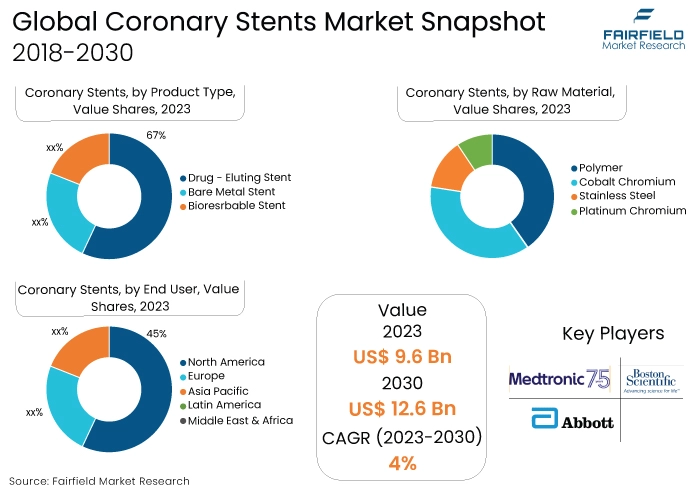
Quick Report Digest
- A notable development in the worldwide market for coronary stents is the expanding utilisation of novel materials, including biodegradable polymers, which improve the biocompatibility of the devices and diminish the occurrence of long-term complications.
- An additional significant development is the increased desire for bioresorbable stents, which is motivated by their capacity to alleviate chronic complications and obviate the necessity for permanent implants, thereby promoting patient-centred methodologies.
- An ongoing development in drug-eluting stent technologies is causing the market to transition in favour of more sophisticated drug delivery mechanisms; these mechanisms provide more precise and efficient treatments for coronary artery diseases.
- An emerging pattern is the adoption of personalised treatment strategies, in which stents are tailored to individual patients according to patient-specific characteristics, resulting in enhanced prognoses and diminished adverse effects.
- The Drug-Eluting Stent segment is anticipated to hold the largest market share in 2022. Its dominance is attributable to the incorporation of drug-eluting capabilities, the prevention of restenosis, and the increasing prevalence of complex cardiovascular cases.
- In 2022, cobalt chromium is anticipated to hold the largest market share among material segments. Material of choice due to its exceptional mechanical properties and biocompatibility, which has contributed to its extensive implementation.
- Hospitals are anticipated to hold the largest market share among market segments in 2022. The sufficiency of their facilities, specialised medical personnel, and established infrastructure all contribute to their pre-eminence as main centres for coronary stent utilisation.
- It is expected that North America will have the highest market penetration rate in the worldwide coronary stents industry. The significant market presence of the region can be attributed to its sophisticated healthcare infrastructure, elevated prevalence of cardiovascular diseases, and robust research and development initiatives.
- Asia Pacific is positioned to experience the most rapid expansion of market penetration. A greater awareness of cardiovascular diseases, increased healthcare expenditures, and an ageing population are all contributing factors to the accelerated adoption of coronary stents in the region.
A Look Back and a Look Forward - Comparative Analysis
The global coronary stents market is presently undergoing substantial expansion, propelled by technological developments, the rising incidence of cardiovascular ailments, and the ageing of the population. The combination of personalised treatment approaches and material advancements, including bioresorbable polymers, is driving an increase in the demand for coronary stents.
In addition, the prevalence of drug-eluting stents, particularly in hospitals, is a substantial factor in the market's ascent. Additional evidence of the market's resilience is the increasing prevalence of sophisticated drug delivery systems, which signifies a transition towards treatment alternatives that are more precise and effective.
Throughout history, the market for coronary stents has undergone significant change. The market has consistently responded to technological advancements, starting with the introduction of bare-metal stents and the ongoing development of drug-eluting stents and novel materials. The dynamic nature of the market is reflected in historical data; developments that have enhanced patient outcomes and decreased long-term complications have strengthened the industry's dedication to innovation.
From a forward-looking perspective, the market outlook for coronary stents is optimistic. The market is anticipated to experience sustained expansion due to ongoing research and development, emerging technologies, and a greater comprehension of patient-specific requirements. The expansion of market penetration, particularly in Asia Pacific regions, highlights the sustained growth potential of the industry.
The global market for coronary stents is positioned for a period of innovation as healthcare systems prioritize cardiovascular care. This is due to the market's ability to address emerging challenges and satisfy the increasing need for personalised and efficient cardiovascular interventions.
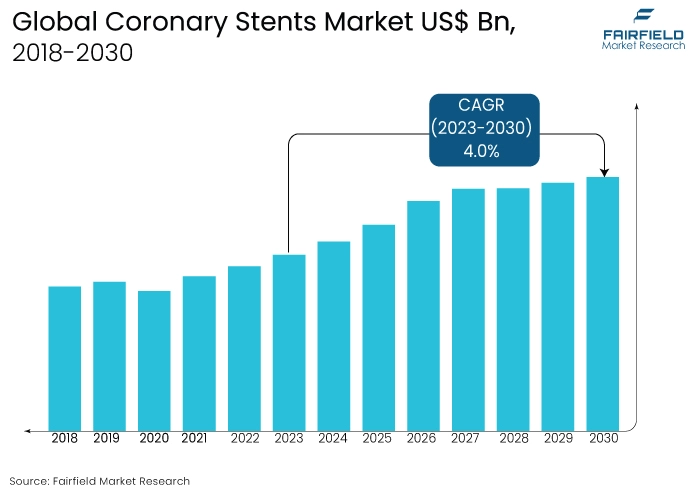
Key Growth Determinants
- Ongoing Developments
The market is significantly influenced by the ongoing development of coronary stent technologies, which is characterised by revolutionary advancements in materials such as bioresorbable polymers and cobalt chromium. These developments reduce complications, improve the biocompatibility of stents, and pave the way for more patient-centric solutions.
The utilisation of technological advancements is crucial in the development of personalised treatment stents, which cater to the specific requirements of each patient. This ensures enhanced effectiveness and diminished adverse effects. The market is propelled by the ever-changing nature of technology, which generates a cycle of innovation that not only resolves present obstacles but also foresees and proactively satisfies the developing needs of cardiovascular care.
- Rising Prevalence of CVDs
The increasing prevalence of cardiovascular diseases (CVDs) on a global scale serves as a substantial catalyst for the expansion of the coronary stent industry. The increasing prevalence of CVDs as a global cause of death has generated a greater need for efficacious interventional therapies such as coronary stents.
The prevalence of coronary artery disease is exacerbated by the increasing incidence of risk factors, including sedentary lifestyles, improper diets, and an ageing population. As a result, there is a pressing need for a greater implementation of stents. This market driver emphasizes the vital function that coronary stents fulfill in alleviating the consequences of cardiovascular diseases, providing patients with a means of survival, and contributing to the ongoing growth of the cardiovascular intervention market.
- Rising Demand for Minimally Invasive Procedures
An important factor propelling the market for coronary stents is the increasing demand for minimally invasive procedures as opposed to conventional open-heart operations. There is a growing preference among both patients and healthcare providers for interventions that accelerate rehabilitation, mitigate discomfort, and shorten recovery periods.
Coronary stents, which are integral components of minimally invasive techniques, enable the accurate and focused management of coronary artery diseases without requiring extensive surgical interventions. The change in treatment preferences is consistent with the overarching healthcare trend towards minimally invasive interventions, which has contributed to the extensive acceptance of coronary stents and is propelling market expansion due to the increasing demand for minimally disruptive procedures.
Major Growth Barriers
- Regulatory Obstacles
The market for coronary implants is constrained by regulatory obstacles and stringent approval procedures. Product launch delays are frequently the result of rigorous regulatory frameworks and convoluted approval processes, impeding the industry's capacity to promptly address emerging trends and fulfill the pressing need for inventive solutions.
- Higher Financial Investments
The considerable financial barrier that coronary stent procedures impose restricts access for specific patient populations. Adoption is impeded by a combination of restricted reimbursement options and affordability concerns. The expansion of the market is impeded by this economic element, specifically in areas where the cost of healthcare is a pivotal determinant of treatment availability.
Key Trends and Opportunities to Look at
- Emergence of Personalised Treatments
The emergence of personalised treatment for coronary stents is a growing trend that prioritizes the customisation of interventions according to the unique characteristics of each patient. The exponential expansion of this phenomenon on a global scale is being propelled by developments in genomics and diagnostic technologies.
Prominent participants in the market are allocating resources towards research endeavours aimed at creating stents tailored to distinct patient profiles. It is anticipated that brands will capitalize on this trend by providing tailored solutions, thereby improving treatment results and patient contentment in various geographical areas.
- Integration of AI-Based Technology
The exponential expansion of AI integration in coronary stent development optimizes treatment planning and outcomes. This trend is especially prevalent in Europe, and North America, where technological infrastructure facilitates the implementation of AI.
Prominent corporations are allocating resources toward AI-powered investigations to improve the accuracy of stent design and deployment. In diverse market environments, brands will probably utilize AI to develop intelligent stents, thereby enhancing procedural efficiency and long-term patient care.
- Growing Inclination Towards Sustainable Manufacturing
The global market is witnessing a growing inclination towards sustainable and bioresorbable materials in the production of coronary stents. This is particularly well-liked in Asia Pacific, and Europe, where environmental consciousness is elevated.
Prominent corporations are engaged in the development of stents utilising biodegradable materials and polymers, thereby adhering to environmentally sustainable practices. It is anticipated that to capitalize on this trend, brands will prioritize sustainability in their product portfolios, thereby attracting environmentally aware consumers and attaining a competitive advantage across various markets.
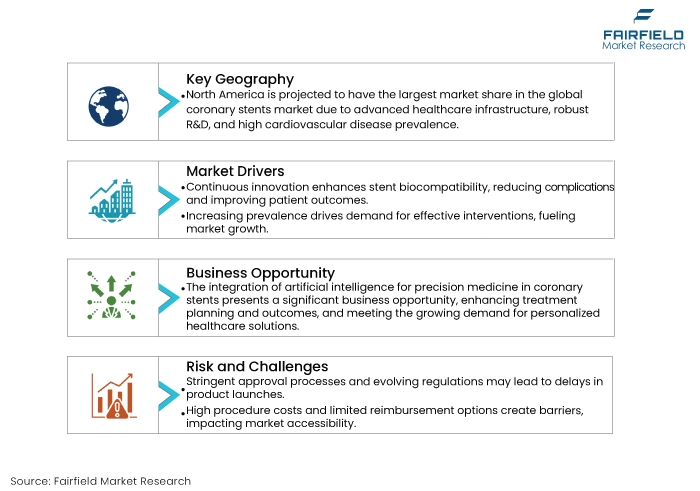
How Does the Regulatory Scenario Shape this Industry?
The global market for coronary stents is significantly impacted by rigorous regulatory frameworks that differ geographically, thereby guaranteeing the safety of patients and the effectiveness of the products. The Food and Drug Administration (FDA) performs a critical function in the United States by enforcing regulations including the Medical Device Regulation Act, which establishes criteria for stent approval.
In Europe, the European Medicines Agency (EMA) governs market access, adhering to the Medical Device Regulation (MDR). These entities conduct thorough examinations of clinical trial data, which can affect the timelines for product approval.
Increased scrutiny has resulted from recent regulatory changes, such as the adoption of MDR in Europe, which has had an impact on market dynamics. Regional discrepancies continue to exist in Asia, despite the National Medical Products Administration (NMPA) of China employing progressive regulatory strategies. These various regulatory frameworks require stench manufacturers to navigate, necessitating conformance strategies that are specific to the regulatory nuances of each region.
Fairfield’s Ranking Board
Top Segments
- Drug-Eluting Stents to be the Most Utilised Product
It is anticipated that the drug-eluting stent (DES) sector will hold the most substantial market share in the worldwide coronary stents industry by 2022. The preponderance of DES in various cardiovascular interventions can be ascribed to its effectiveness in preventing restenosis via drug release mechanisms, rendering it a favoured option among clinicians.
On the contrary, it is expected that the bioresorbable stent segment will experience the most rapid growth. The rising need for stents that decompose progressively once they have fulfilled their intended function corresponds to an expanding focus on mitigating chronic complications and enhancing patient results. With ongoing technological progress improving the functionality and compatibility of bioresorbable stents, this particular market segment is anticipated to experience substantial growth in the coming years.
- Cobalt Chromium to be the Most Valued Raw Material During Manufacturing
The cobalt chromium segment is anticipated to hold the largest market share of the global coronary stents market in 2022. Cobalt chromium stents are highly regarded by healthcare professionals for coronary interventions due to their enhanced biocompatibility and superior mechanical properties.
In contrast, the fastest-growing segment is anticipated to be polymers. Profound progressions in polymer technology have precipitated the emergence of novel stent configurations, which present enhanced adaptability and capabilities for drug delivery. The polymer segment is anticipated to experience substantial growth due to the increasing demand for sophisticated and user-friendly solutions. This expansion will be propelled by continuous research and development endeavours within the coronary stents market.
- Hospitals to Accommodate the Widest Consumer Base
The Hospitals segment is anticipated to hold the most substantial market share in the worldwide coronary stents market by 2022. Hospitals function as principal hubs for cardiovascular interventions, owing to their well-developed infrastructure and specialised medical personnel, which enables them to maintain a dominant position in the utilisation of coronary stents.
In contrast, it is anticipated that the ambulatory surgical centres (ASCs) sector will experience the most rapid expansion. The increasing preference for minimally invasive interventions and the transition toward ambulatory procedures are the primary drivers of demand for coronary stents in ASCs. These facilities provide advantages such as convenience, shorter hospital stays, and cost-efficiency, which significantly contribute to the worldwide surge in coronary stent adoption.
Regional Frontrunners
North America Retains a Dominant Position with Sophisticated Healthcare Infrastructure
It is anticipated that North America will hold the largest market share of the worldwide coronary stents industry. The area is distinguished by its sophisticated healthcare infrastructure, substantial investments in research and development, and a notable incidence of cardiovascular diseases.
North America's dominance can be attributed to the early adoption of innovative technologies and the presence of a well-established regulatory framework. Furthermore, the region's market hegemony in coronary stents is coherent with a substantial emphasis on personalised medicine and innovative interventions.
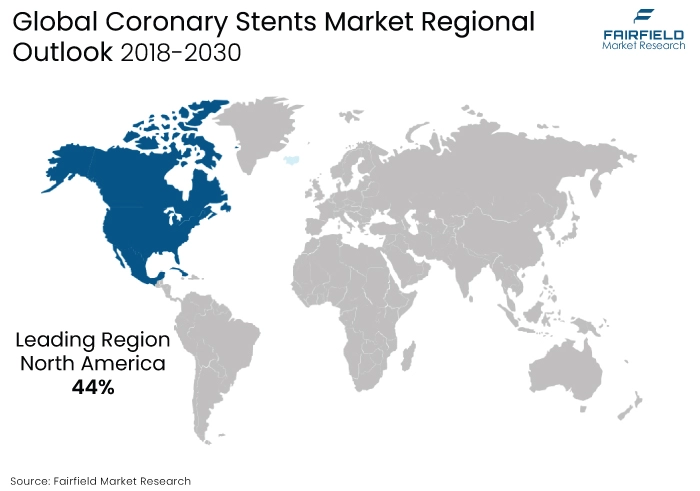
Asia Pacific Expects Large Gains from a Surge in Healthcare Expenditure
Asia Pacific is anticipated to experience the most rapid expansion of any region in the world's coronary stents market. A rise in the prevalence of cardiovascular diseases is observed in the region, which is accompanied by increased healthcare expenditures and awareness.
Prompt economic growth, the expansion of the elderly demographic, and progress in healthcare infrastructure are all factors that contribute to the accelerated adoption of coronary stents. With the ongoing development of healthcare infrastructure and the increasing availability of advanced treatments, the Asia Pacific region is emerging as a prominent area for the most rapid market penetration in the coronary stent industry.
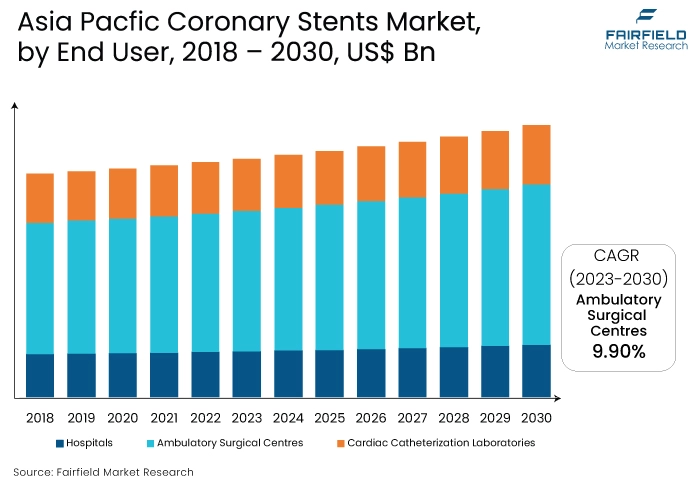
Fairfield’s Competitive Landscape Analysis
Competitive dynamics are significantly reshaping the coronary stents market, which is undergoing a dynamic transformation. Companies' positioning is being influenced by the integration of artificial intelligence, a shift toward personalised treatment paradigms, and an emphasis on biodegradable and sustainable materials. The adaptability and resilience of supply chains will be critical for businesses to satisfy fluctuating market demands and regulatory shifts.
At present, pricing frameworks are an indication of the equilibrium that exists between technological progress and market rivalry. Over time, the pricing strategy employed for coronary stents is anticipated to have a significant impact on the expansion of the market.
Sustained growth is anticipated to be driven by a shift towards affordability and accessibility. In general, those who possess the ability to effectively incorporate innovation, manoeuvre through regulatory intricacies, and respond to the changing demands of healthcare providers and patients will secure a prosperous future for the market.
Who are the Leading Players in the Coronary Stents Market Space?
- Medtronic
- Abbott
- Boston Scientific Corporation
- B Braun Melsungen AG
- Terumo Corporation
- MicroPort Scientific Corporation
- Biotronik
- R. Bard, Inc.
- Stentys SA
- Cook Medical
Significant Company Developments
New Product Launch
- April 2021: Abbott said that Ultreon 1.0 Software powered by Al, a coronary imageing platform, is now available in Europe. The programme was introduced with the intention of enhancing the measurement of channel diameter and the identification of calcium-based obstructions during coronary stenting operations.
- February 2021: The goal of the cooperation between Cardiovascular Systems Inc., and Chansu Vascular Technologies, LLC is to produce drug-coated balloons for peripheral and coronary circulation that may be used in drug-eluting stents.
An Expert’s Eye
Demand and Future Growth
The market for coronary stents exhibits a positive long-term outlook, predominantly driven by the ever-changing environment of cardiovascular care. The continued prevalence of lifestyle-related cardiovascular diseases and the ageing of the global population are expected to sustain a strong demand for advanced interventions such as coronary stents.
Additionally, technological advancements and the rising prevalence of personalised medicine, including bioresorbable stents and AI-powered treatments, are anticipated to make substantial contributions to the sustained expansion of the market.
Present demand-supply dynamics suggest that there is an increasing requirement for patient-tailored and more efficient solutions; this presents industry participants who are prepared to allocate resources towards research and development with a significant market opportunity.
Supply Side of the Market
Industry participants encounter the challenge of satisfying the increasing demand with inventive and economically viable solutions on the supply side. The manufacturing and dissemination of coronary stents entail complex procedures, which necessitate strict adherence to rigorous regulatory criteria.
Achieving a harmonious coexistence among upholding product quality, manoeuvring intricate regulatory environments, and guaranteeing cost-effectiveness for manufacturers and end-users constitutes a formidable task. To streamline production processes, optimize distribution channels, and guarantee timely access to coronary stents in various healthcare settings, it is critical to conduct a comprehensive supply chain analysis.
Global Coronary Stents Market is Segmented as Below:
By Product Type:
- Drug-Eluting Stent
- Bare Metal Stent
- Bioresorbable stent
By Raw Material Type:
- Cobalt Chromium
- Stainless Steel
- Platinum Chromium
- Polymer
By End User:
- Hospitals
- Ambulatory Surgical Centres
- Cardiac Catheterization Laboratories
By Geographic Coverage:
- North America
- U.S.
- Canada
- Europe
- Germany
- U.K.
- France
- Italy
- Turkey
- Russia
- Rest of Europe
- Asia Pacific
- China
- Japan
- South Korea
- India
- Southeast Asia
- Rest of Asia Pacific
- Latin America
- Brazil
- Mexico
- Argentina
- Rest of Latin America
- Middle East & Africa
- GCC
- South Africa
- Egypt
- Nigeria
- Rest of the Middle East & Africa
1. Executive Summary
1.1. Global Coronary Stents Market Snapshot
1.2. Future Projections
1.3. Key Market Trends
1.4. Regional Snapshot, by Value, 2022
1.5. Analyst Recommendations
2. Market Overview
2.1. Market Definitions and Segmentations
2.2. Market Dynamics
2.2.1. Drivers
2.2.2. Restraints
2.2.3. Market Opportunities
2.3. Value Chain Analysis
2.4. Porter’s Five Forces Analysis
2.5. Covid-19 Impact Analysis
2.5.1. Supply
2.5.2. Demand
2.6. Impact of Ukraine-Russia Conflict
2.7. Economic Overview
2.7.1. World Economic Projections
2.8. PESTLE Analysis
3. Global Coronary Stents Market Outlook, 2018 - 2030
3.1. Global Coronary Stents Market Outlook, by Product Type, Value (US$ Mn), 2018 - 2030
3.1.1. Key Highlights
3.1.1.1. Drug - Eluting Stent
3.1.1.2. Bare Metal Stent
3.1.1.3. Bioresrbable stent
3.2. Global Coronary Stents Market Outlook, by Raw Material Type, Value (US$ Mn), 2018 - 2030
3.2.1. Key Highlights
3.2.1.1. Cobalt Chromium
3.2.1.2. Stainless Steel
3.2.1.3. Platinum Chromium
3.2.1.4. Polymer
3.3. Global Coronary Stents Market Outlook, by End User, Value (US$ Mn), 2018 - 2030
3.3.1. Key Highlights
3.3.1.1. Hospitals
3.3.1.2. Ambulatory Surgical Centres
3.3.1.3. Cardiac Catheterization Laboratories
3.4. Global Coronary Stents Market Outlook, by Region, Value (US$ Mn), 2018 - 2030
3.4.1. Key Highlights
3.4.1.1. North America
3.4.1.2. Europe
3.4.1.3. Asia Pacific
3.4.1.4. Latin America
3.4.1.5. Middle East & Africa
4. North America Coronary Stents Market Outlook, 2018 - 2030
4.1. North America Coronary Stents Market Outlook, by Product Type, Value (US$ Mn), 2018 - 2030
4.1.1. Key Highlights
4.1.1.1. Drug - Eluting Stent
4.1.1.2. Bare Metal Stent
4.1.1.3. Bioresrbable stent
4.2. North America Coronary Stents Market Outlook, by Raw Material Type, Value (US$ Mn), 2018 - 2030
4.2.1. Key Highlights
4.2.1.1. Cobalt Chromium
4.2.1.2. Stainless Steel
4.2.1.3. Platinum Chromium
4.2.1.4. Polymer
4.3. North America Coronary Stents Market Outlook, by End User, Value (US$ Mn), 2018 - 2030
4.3.1. Key Highlights
4.3.1.1. Hospitals
4.3.1.2. Ambulatory Surgical Centres
4.3.1.3. Cardiac Catheterization Laboratories
4.3.2. BPS Analysis/Market Attractiveness Analysis
4.4. North America Coronary Stents Market Outlook, by Country, Value (US$ Mn), 2018 - 2030
4.4.1. Key Highlights
4.4.1.1. U.S. Coronary Stents Market by Product Type, Value (US$ Mn), 2018 - 2030
4.4.1.2. U.S. Coronary Stents Market Raw Material Type, Value (US$ Mn), 2018 - 2030
4.4.1.3. U.S. Coronary Stents Market End User, Value (US$ Mn), 2018 - 2030
4.4.1.4. Canada Coronary Stents Market by Product Type, Value (US$ Mn), 2018 - 2030
4.4.1.5. Canada Coronary Stents Market Raw Material Type, Value (US$ Mn), 2018 - 2030
4.4.1.6. Canada Coronary Stents Market End User, Value (US$ Mn), 2018 - 2030
4.4.2. BPS Analysis/Market Attractiveness Analysis
5. Europe Coronary Stents Market Outlook, 2018 - 2030
5.1. Europe Coronary Stents Market Outlook, by Product Type, Value (US$ Mn), 2018 - 2030
5.1.1. Key Highlights
5.1.1.1. Drug - Eluting Stent
5.1.1.2. Bare Metal Stent
5.1.1.3. Bioresrbable stent
5.2. Europe Coronary Stents Market Outlook, by Raw Material Type, Value (US$ Mn), 2018 - 2030
5.2.1. Key Highlights
5.2.1.1. Cobalt Chromium
5.2.1.2. Stainless Steel
5.2.1.3. Platinum Chromium
5.2.1.4. Polymer
5.3. Europe Coronary Stents Market Outlook, by End User, Value (US$ Mn), 2018 - 2030
5.3.1. Key Highlights
5.3.1.1. Hospitals
5.3.1.2. Ambulatory Surgical Centres
5.3.1.3. Cardiac Catheterization Laboratories
5.3.2. BPS Analysis/Market Attractiveness Analysis
5.4. Europe Coronary Stents Market Outlook, by Country, Value (US$ Mn), 2018 - 2030
5.4.1. Key Highlights
5.4.1.1. Germany Coronary Stents Market by Product Type, Value (US$ Mn), 2018 - 2030
5.4.1.2. Germany Coronary Stents Market Raw Material Type, Value (US$ Mn), 2018 - 2030
5.4.1.3. Germany Coronary Stents Market End User, Value (US$ Mn), 2018 - 2030
5.4.1.4. U.K. Coronary Stents Market by Product Type, Value (US$ Mn), 2018 - 2030
5.4.1.5. U.K. Coronary Stents Market Raw Material Type, Value (US$ Mn), 2018 - 2030
5.4.1.6. U.K. Coronary Stents Market End User, Value (US$ Mn), 2018 - 2030
5.4.1.7. France Coronary Stents Market by Product Type, Value (US$ Mn), 2018 - 2030
5.4.1.8. France Coronary Stents Market Raw Material Type, Value (US$ Mn), 2018 - 2030
5.4.1.9. France Coronary Stents Market End User, Value (US$ Mn), 2018 - 2030
5.4.1.10. Italy Coronary Stents Market by Product Type, Value (US$ Mn), 2018 - 2030
5.4.1.11. Italy Coronary Stents Market Raw Material Type, Value (US$ Mn), 2018 - 2030
5.4.1.12. Italy Coronary Stents Market End User, Value (US$ Mn), 2018 - 2030
5.4.1.13. Turkey Coronary Stents Market by Product Type, Value (US$ Mn), 2018 - 2030
5.4.1.14. Turkey Coronary Stents Market Raw Material Type, Value (US$ Mn), 2018 - 2030
5.4.1.15. Turkey Coronary Stents Market End User, Value (US$ Mn), 2018 - 2030
5.4.1.16. Russia Coronary Stents Market by Product Type, Value (US$ Mn), 2018 - 2030
5.4.1.17. Russia Coronary Stents Market Raw Material Type, Value (US$ Mn), 2018 - 2030
5.4.1.18. Russia Coronary Stents Market End User, Value (US$ Mn), 2018 - 2030
5.4.1.19. Rest of Europe Coronary Stents Market by Product Type, Value (US$ Mn), 2018 - 2030
5.4.1.20. Rest of Europe Coronary Stents Market Raw Material Type, Value (US$ Mn), 2018 - 2030
5.4.1.21. Rest of Europe Coronary Stents Market End User, Value (US$ Mn), 2018 - 2030
5.4.2. BPS Analysis/Market Attractiveness Analysis
6. Asia Pacific Coronary Stents Market Outlook, 2018 - 2030
6.1. Asia Pacific Coronary Stents Market Outlook, by Product Type, Value (US$ Mn), 2018 - 2030
6.1.1. Key Highlights
6.1.1.1. Drug - Eluting Stent
6.1.1.2. Bare Metal Stent
6.1.1.3. Bioresrbable stent
6.2. Asia Pacific Coronary Stents Market Outlook, by Raw Material Type, Value (US$ Mn), 2018 - 2030
6.2.1. Key Highlights
6.2.1.1. Cobalt Chromium
6.2.1.2. Stainless Steel
6.2.1.3. Platinum Chromium
6.2.1.4. Polymer
6.3. Asia Pacific Coronary Stents Market Outlook, by End User, Value (US$ Mn), 2018 - 2030
6.3.1. Key Highlights
6.3.1.1. Hospitals
6.3.1.2. Ambulatory Surgical Centres
6.3.1.3. Cardiac Catheterization Laboratories
6.3.2. BPS Analysis/Market Attractiveness Analysis
6.4. Asia Pacific Coronary Stents Market Outlook, by Country, Value (US$ Mn), 2018 - 2030
6.4.1. Key Highlights
6.4.1.1. China Coronary Stents Market by Product Type, Value (US$ Mn), 2018 - 2030
6.4.1.2. China Coronary Stents Market Raw Material Type, Value (US$ Mn), 2018 - 2030
6.4.1.3. China Coronary Stents Market End User, Value (US$ Mn), 2018 - 2030
6.4.1.4. Japan Coronary Stents Market by Product Type, Value (US$ Mn), 2018 - 2030
6.4.1.5. Japan Coronary Stents Market Raw Material Type, Value (US$ Mn), 2018 - 2030
6.4.1.6. Japan Coronary Stents Market End User, Value (US$ Mn), 2018 - 2030
6.4.1.7. South Korea Coronary Stents Market by Product Type, Value (US$ Mn), 2018 - 2030
6.4.1.8. South Korea Coronary Stents Market Raw Material Type, Value (US$ Mn), 2018 - 2030
6.4.1.9. South Korea Coronary Stents Market End User, Value (US$ Mn), 2018 - 2030
6.4.1.10. India Coronary Stents Market by Product Type, Value (US$ Mn), 2018 - 2030
6.4.1.11. India Coronary Stents Market Raw Material Type, Value (US$ Mn), 2018 - 2030
6.4.1.12. India Coronary Stents Market End User, Value (US$ Mn), 2018 - 2030
6.4.1.13. Southeast Asia Coronary Stents Market by Product Type, Value (US$ Mn), 2018 - 2030
6.4.1.14. Southeast Asia Coronary Stents Market Raw Material Type, Value (US$ Mn), 2018 - 2030
6.4.1.15. Southeast Asia Coronary Stents Market End User, Value (US$ Mn), 2018 - 2030
6.4.1.16. Rest of Asia Pacific Coronary Stents Market by Product Type, Value (US$ Mn), 2018 - 2030
6.4.1.17. Rest of Asia Pacific Coronary Stents Market Raw Material Type, Value (US$ Mn), 2018 - 2030
6.4.1.18. Rest of Asia Pacific Coronary Stents Market End User, Value (US$ Mn), 2018 - 2030
6.4.2. BPS Analysis/Market Attractiveness Analysis
7. Latin America Coronary Stents Market Outlook, 2018 - 2030
7.1. Latin America Coronary Stents Market Outlook, by Product Type, Value (US$ Mn), 2018 - 2030
7.1.1. Key Highlights
7.1.1.1. Drug - Eluting Stent
7.1.1.2. Bare Metal Stent
7.1.1.3. Bioresrbable stent
7.2. Latin America Coronary Stents Market Outlook, by Raw Material Type, Value (US$ Mn), 2018 - 2030
7.2.1. Key Highlights
7.2.1.1. Cobalt Chromium
7.2.1.2. Stainless Steel
7.2.1.3. Platinum Chromium
7.2.1.4. Polymer
7.3. Latin America Coronary Stents Market Outlook, by End User, Value (US$ Mn), 2018 - 2030
7.3.1. Key Highlights
7.3.1.1. Hospitals
7.3.1.2. Ambulatory Surgical Centres
7.3.1.3. Cardiac Catheterization Laboratories
7.3.2. BPS Analysis/Market Attractiveness Analysis
7.4. Latin America Coronary Stents Market Outlook, by Country, Value (US$ Mn), 2018 - 2030
7.4.1. Key Highlights
7.4.1.1. Brazil Coronary Stents Market by Product Type, Value (US$ Mn), 2018 - 2030
7.4.1.2. Brazil Coronary Stents Market Raw Material Type, Value (US$ Mn), 2018 - 2030
7.4.1.3. Brazil Coronary Stents Market End User, Value (US$ Mn), 2018 - 2030
7.4.1.4. Mexico Coronary Stents Market by Product Type, Value (US$ Mn), 2018 - 2030
7.4.1.5. Mexico Coronary Stents Market Raw Material Type, Value (US$ Mn), 2018 - 2030
7.4.1.6. Mexico Coronary Stents Market End User, Value (US$ Mn), 2018 - 2030
7.4.1.7. Argentina Coronary Stents Market by Product Type, Value (US$ Mn), 2018 - 2030
7.4.1.8. Argentina Coronary Stents Market Raw Material Type, Value (US$ Mn), 2018 - 2030
7.4.1.9. Argentina Coronary Stents Market End User, Value (US$ Mn), 2018 - 2030
7.4.1.10. Rest of Latin America Coronary Stents Market by Product Type, Value (US$ Mn), 2018 - 2030
7.4.1.11. Rest of Latin America Coronary Stents Market Raw Material Type, Value (US$ Mn), 2018 - 2030
7.4.1.12. Rest of Latin America Coronary Stents Market End User, Value (US$ Mn), 2018 - 2030
7.4.2. BPS Analysis/Market Attractiveness Analysis
8. Middle East & Africa Coronary Stents Market Outlook, 2018 - 2030
8.1. Middle East & Africa Coronary Stents Market Outlook, by Product Type, Value (US$ Mn), 2018 - 2030
8.1.1. Key Highlights
8.1.1.1. Drug - Eluting Stent
8.1.1.2. Bare Metal Stent
8.1.1.3. Bioresrbable stent
8.2. Middle East & Africa Coronary Stents Market Outlook, by Raw Material Type, Value (US$ Mn), 2018 - 2030
8.2.1. Key Highlights
8.2.1.1. Cobalt Chromium
8.2.1.2. Stainless Steel
8.2.1.3. Platinum Chromium
8.2.1.4. Polymer
8.3. Middle East & Africa Coronary Stents Market Outlook, by End User, Value (US$ Mn), 2018 - 2030
8.3.1. Key Highlights
8.3.1.1. Hospitals
8.3.1.2. Ambulatory Surgical Centres
8.3.1.3. Cardiac Catheterization Laboratories
8.4. Middle East & Africa Coronary Stents Market Outlook, by Country, Value (US$ Mn), 2018 - 2030
8.4.1. Key Highlights
8.4.1.1. GCC Coronary Stents Market by Product Type, Value (US$ Mn), 2018 - 2030
8.4.1.2. GCC Coronary Stents Market Raw Material Type, Value (US$ Mn), 2018 - 2030
8.4.1.3. GCC Coronary Stents Market End User, Value (US$ Mn), 2018 - 2030
8.4.1.4. South Africa Coronary Stents Market by Product Type, Value (US$ Mn), 2018 - 2030
8.4.1.5. South Africa Coronary Stents Market Raw Material Type, Value (US$ Mn), 2018 - 2030
8.4.1.6. South Africa Coronary Stents Market End User, Value (US$ Mn), 2018 - 2030
8.4.1.7. Egypt Coronary Stents Market by Product Type, Value (US$ Mn), 2018 - 2030
8.4.1.8. Egypt Coronary Stents Market Raw Material Type, Value (US$ Mn), 2018 - 2030
8.4.1.9. Egypt Coronary Stents Market End User, Value (US$ Mn), 2018 - 2030
8.4.1.10. Nigeria Coronary Stents Market by Product Type, Value (US$ Mn), 2018 - 2030
8.4.1.11. Nigeria Coronary Stents Market Raw Material Type, Value (US$ Mn), 2018 - 2030
8.4.1.12. Nigeria Coronary Stents Market End User, Value (US$ Mn), 2018 - 2030
8.4.1.13. Rest of Middle East & Africa Coronary Stents Market by Product Type, Value (US$ Mn), 2018 - 2030
8.4.1.14. Rest of Middle East & Africa Coronary Stents Market Raw Material Type, Value (US$ Mn), 2018 - 2030
8.4.1.15. Rest of Middle East & Africa Coronary Stents Market End User, Value (US$ Mn), 2018 - 2030
8.4.2. BPS Analysis/Market Attractiveness Analysis
9. Appendix
9.1. Research Methodology
9.2. Report Assumptions
9.3. Acronyms and Abbreviations
|
BASE YEAR |
HISTORICAL DATA |
FORECAST PERIOD |
UNITS |
|||
|
2022 |
|
2018 - 2022 |
2023 - 2030 |
Value: US$ Million |
||
|
REPORT FEATURES |
DETAILS |
|
Product Type Coverage |
|
|
Raw Material Coverage |
|
|
End User Coverage |
|
|
Geographical Coverage |
|
|
Leading Companies |
|
|
Report Highlights |
Key Market Indicators, Macro-micro economic impact analysis, Technological Roadmap, Key Trends, Driver, Restraints, and Future Opportunities & Revenue Pockets, Porter’s 5 Forces Analysis, Historical Trend (2019-2021), Market Estimates and Forecast, Market Dynamics, Industry Trends, Competition Landscape, Category, Region, Country-wise Trends & Analysis, COVID-19 Impact Analysis (Demand and Supply Chain) |
